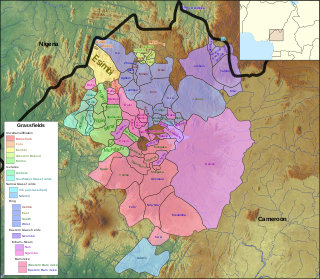Labial consonants are consonants in which one or both lips are the active articulator. The two common labial articulations are bilabials, articulated using both lips, and labiodentals, articulated with the lower lip against the upper teeth, both of which are present in English. A third labial articulation is dentolabials, articulated with the upper lip against the lower teeth, normally only found in pathological speech. Generally precluded are linguolabials, in which the tip of the tongue contacts the posterior side of the upper lip, making them coronals, though sometimes, they behave as labial consonants.

Anadarko is a city and county seat of Caddo County, Oklahoma, United States. The city is fifty miles (80.5 km) southwest of Oklahoma City. The population was 5,745 at the 2020 census.

Wichita is an extinct Caddoan language once spoken in Oklahoma by the Wichita and Affiliated Tribes. The last fluent heritage speaker, Doris Lamar-McLemore, died in 2016, although in 2007 there were three first-language speakers alive. This has rendered Wichita functionally extinct; however, the tribe offers classes to revitalize the language and works in partnership with the Wichita Documentation Project of the University of Colorado, Boulder.

The Caddoan languages are a family of languages native to the Great Plains spoken by tribal groups of the central United States, from present-day North Dakota south to Oklahoma. All Caddoan languages are critically endangered, as the number of speakers has declined markedly due to colonial legacy, lack of support, and other factors.

The Yonaguni language is a Southern Ryukyuan language spoken by around 400 people on the island of Yonaguni, in the Ryukyu Islands, the westernmost of the chain lying just east of Taiwan. It is most closely related to Yaeyama. Due to the Japanese policy on languages, the language is not recognized by the government, which instead calls it the Yonaguni dialect. As classified by UNESCO, the Yonaguni language is one of the most endangered languages in all of Japan, after the Ainu language.

The Wichita people, or Kitikiti'sh, are a confederation of Southern Plains Native American tribes. Historically they spoke the Wichita language and Kichai language, both Caddoan languages. They are indigenous to Oklahoma, Texas, and Kansas.

Caddo is a Native American language, the traditional language of the Caddo Nation. It is critically endangered, with no exclusively Caddo-speaking community and as of 2023 only two speakers who had acquired the language as children outside school instruction, down from 25 speakers in 1997. Caddo has several mutually intelligible dialects. The most commonly used dialects are Hasinai and Hainai; others include Kadohadacho, Natchitoches and Yatasi.

The Kichai tribe was a Native American Southern Plains tribe that lived in Texas, Louisiana, and Oklahoma. Their name for themselves was K'itaish.
The phonological system of the Polish language is similar in many ways to those of other Slavic languages, although there are some characteristic features found in only a few other languages of the family, such as contrasting postalveolar and alveolo-palatal fricatives and affricates. The vowel system is relatively simple, with just six oral monophthongs and arguably two nasals in traditional speech, while the consonant system is much more complex.
Chiwere is a Siouan language originally spoken by the Missouria, Otoe, and Iowa peoples, who originated in the Great Lakes region but later moved throughout the Midwest and plains. The language is closely related to Ho-Chunk, also known as Winnebago.
The pronunciation of the digraph ⟨wh⟩ in English has changed over time, and still varies today between different regions and accents. It is now most commonly pronounced, the same as a plain initial ⟨w⟩, although some dialects, particularly those of Scotland, Ireland, and the Southern United States, retain the traditional pronunciation, generally realized as, a voiceless "w" sound. The process by which the historical has become in most modern varieties of English is called the wine–whine merger. It is also referred to as glide cluster reduction.
The Yatasi were Native American peoples from northwestern Louisiana that were part of the Natchitoches Confederacy of the Caddo Nation. Today they are enrolled in the Caddo Nation of Oklahoma.
Sio is an Austronesian language spoken by about 3,500 people on the north coast of the Huon Peninsula in Morobe Province, Papua New Guinea. According to Harding and Clark (1994), Sio speakers lived in a single village on a small offshore island until the Pacific War, after which they established four villages on the nearby coast: Lambutina, Basakalo, Laelo, and Balambu. Nambariwa, another coastal village a few miles to the east, is also Sio-speaking.
The Eyeish were a Native American tribe from present-day eastern Texas.
The Nadaco, also commonly known as the Anduico, are a Native American tribe from eastern Texas. Their name, Nadá-kuh, means "bumblebee place."
The Nabiti are a Native American tribe from eastern Texas. Their name means "Cedar Place" in the Caddo language.
The Nabedache were a Native American tribe from eastern Texas. Their name, Nabáydácu, means "blackberry place" in the Caddo language. An alternate theory says their original name was Wawadishe from the Caddo word, witish, meaning "salt."

The Waco of the Wichita people are a Southern Plains Native American tribe that inhabited northeastern Texas. Today, they are enrolled members of the federally recognized Wichita and Affiliated Tribes, headquartered in Anadarko, Oklahoma.
Maring, also known as Mareng or Yoadabe-Watoare, is a Trans–New Guinea language of the Chimbu–Wahgi branch. Speakers of the language can be found in the Bismarck range of the Madang province or in the Hagen district of the Western Highlands province. Dialects of the Maring language are Central Maring, Eastern Maring, Timbunki, Tsuwenki, Karamba, and Kambegl. All Maring speakers can understand the Central Maring dialect.

Babanki, or Kejom, is a Bantoid language that is spoken by the Babanki people of the Western Highlands of Cameroon.
 (retrieved 3 May 2010)
(retrieved 3 May 2010)






